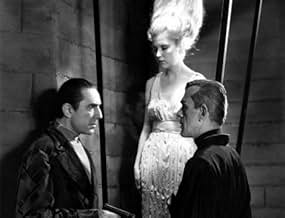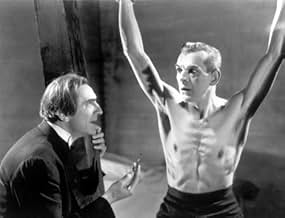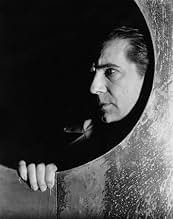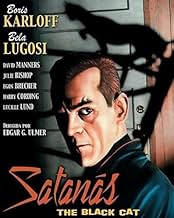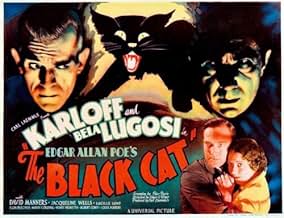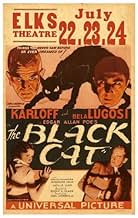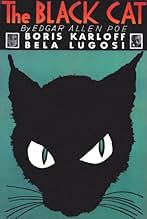Des Américains en lune de miel en Hongrie se retrouvent piégés dans la maison d'un prêtre adorateur de Satan lorsque la mariée y est emmenée pour recevoir une aide médicale suite à un accide... Tout lireDes Américains en lune de miel en Hongrie se retrouvent piégés dans la maison d'un prêtre adorateur de Satan lorsque la mariée y est emmenée pour recevoir une aide médicale suite à un accident de la route.Des Américains en lune de miel en Hongrie se retrouvent piégés dans la maison d'un prêtre adorateur de Satan lorsque la mariée y est emmenée pour recevoir une aide médicale suite à un accident de la route.
- Réalisation
- Scénario
- Casting principal
- Récompenses
- 2 victoires et 1 nomination au total
Boris Karloff
- Hjalmar Poelzig
- (as Karloff)
Julie Bishop
- Joan Alison
- (as Jacqueline Wells)
Virginia Ainsworth
- Cultist
- (non crédité)
Luis Alberni
- Train Steward
- (non crédité)
King Baggot
- Cultist
- (non crédité)
Herman Bing
- Car Steward
- (non crédité)
Symona Boniface
- Cultist
- (non crédité)
John Carradine
- Cult Organist
- (non crédité)
André Cheron
- Train Conductor
- (non crédité)
George Davis
- Bus driver
- (non crédité)
Andy Devine
- Bit Part
- (non crédité)
Avis à la une
Travelling across Eastern Europe, Peter and Joan Allison meet Dr Werdegast on the train. When the bus taking them to their destination crashes, the Allisons go with Werdegast and stay with him at the foreboding castle of Hjalmar Poelzig. However the Allisons find themselves in danger when it becomes apparent that Werdegast and Poelzig have a deadly history with each other.
Although it carries the title of his book and a credit for him on the titles, this film has little to do with Poe's work. In fact, in terms of plotting, it owes very little to anybody because, aside from the actual set up, the plot just goes all to hell very quickly. The set up is interesting and I wanted to know more about the history between these two men, then there is the thing about the black cat and Werdegast, not to mention the fact that Poelzig seems to be very interested in reading about satanic cults! However, none of this is really fully explained - this is partly due to the short run time and so much material, but it must also be blamed on the film not having a strong focus other than atmosphere.
The film still works well as the plot crumbles, but it is a little unsatisfying as it leaves so many half stories and unanswered questions. What it does do well though is atmosphere, the direction is cheap but effective and the lighting works wonders in a cheap set! The cast also contribute to this focus on atmosphere (or style) over plot (or substance). Karloff overdoes things, but he overdoes them very well! There is no real need for him to be as ominous as he is at the start but it is what we have come to expect from him. Lugosi may have tarnished his reputation towards the end of his career, but he is good here. It's hard not to laugh when seeing him convulsed with fear over the cat but he plays it well for the most part. Manners and Wells are both OK but are very much the onscreen representation of the audience and simply have to act shocked by everything and run away lots!
Overall this is a good film but only because of the atmosphere and the influence of two legendary stars in the cast. The plot had potential but not enough time is allowed for it to be explored and the focus is more on the atmosphere than the construction.
Although it carries the title of his book and a credit for him on the titles, this film has little to do with Poe's work. In fact, in terms of plotting, it owes very little to anybody because, aside from the actual set up, the plot just goes all to hell very quickly. The set up is interesting and I wanted to know more about the history between these two men, then there is the thing about the black cat and Werdegast, not to mention the fact that Poelzig seems to be very interested in reading about satanic cults! However, none of this is really fully explained - this is partly due to the short run time and so much material, but it must also be blamed on the film not having a strong focus other than atmosphere.
The film still works well as the plot crumbles, but it is a little unsatisfying as it leaves so many half stories and unanswered questions. What it does do well though is atmosphere, the direction is cheap but effective and the lighting works wonders in a cheap set! The cast also contribute to this focus on atmosphere (or style) over plot (or substance). Karloff overdoes things, but he overdoes them very well! There is no real need for him to be as ominous as he is at the start but it is what we have come to expect from him. Lugosi may have tarnished his reputation towards the end of his career, but he is good here. It's hard not to laugh when seeing him convulsed with fear over the cat but he plays it well for the most part. Manners and Wells are both OK but are very much the onscreen representation of the audience and simply have to act shocked by everything and run away lots!
Overall this is a good film but only because of the atmosphere and the influence of two legendary stars in the cast. The plot had potential but not enough time is allowed for it to be explored and the focus is more on the atmosphere than the construction.
Other commentaries will fill you in on the nearly-incomprehensible plot (if that's possible) but, as has been pointed out, you don't watch a film like this for plot.
Despite the story inconsistencies and implausibilities, everything here just seems to "jell:" the fabulous sets, elegant photography, evocative music (drawing heavily from Schubert, among others) and the downright creepy atmosphere woven from the themes of jealousy, lust, revenge, murder, sadism.....all sounds delightfully sick, doesn't it? Truly, it's nowhere near as threatening as it sounds; indeed, if Astaire and Rogers had ever made a spooky thriller, it might have looked and felt something like this one. THE BLACK CAT possesses a lyrical, rhythmic quality, upon which we drift through a sleek, ultra-modern nightmare world.
One of the reasons it all works is its ability to pull us into a sort of parallel universe which, though it looks more or less like reality as we know it, glides along on a barely-concealed undercurrent - an "atmosphere of death," as Lugosi's character puts it - where things happen that "could never actually happen" (an inside reference for those who know the film).
There are some wonderful set-pieces, such as Karloff's tour through a most unusual basement mausoleum/museum memorializing all of his dearly departed earlier "wives." And of course, Boris and Bela deliver, with their restrained but full-bodied performances. Karloff conveys menace just entering a room, and Lugosi has an all-too-rare opportunity to display some tenderness; notice the single tear that rolls down his face as he learns - and sees - what became of the wife that Karloff stole from him years before.
A very stylized - and stylish - film which grants us the unusual treat of seeing Lugosi play a (more or less) "good guy," and the unique one of hearing him pronounce the word "baloney," as only he could.
Despite the story inconsistencies and implausibilities, everything here just seems to "jell:" the fabulous sets, elegant photography, evocative music (drawing heavily from Schubert, among others) and the downright creepy atmosphere woven from the themes of jealousy, lust, revenge, murder, sadism.....all sounds delightfully sick, doesn't it? Truly, it's nowhere near as threatening as it sounds; indeed, if Astaire and Rogers had ever made a spooky thriller, it might have looked and felt something like this one. THE BLACK CAT possesses a lyrical, rhythmic quality, upon which we drift through a sleek, ultra-modern nightmare world.
One of the reasons it all works is its ability to pull us into a sort of parallel universe which, though it looks more or less like reality as we know it, glides along on a barely-concealed undercurrent - an "atmosphere of death," as Lugosi's character puts it - where things happen that "could never actually happen" (an inside reference for those who know the film).
There are some wonderful set-pieces, such as Karloff's tour through a most unusual basement mausoleum/museum memorializing all of his dearly departed earlier "wives." And of course, Boris and Bela deliver, with their restrained but full-bodied performances. Karloff conveys menace just entering a room, and Lugosi has an all-too-rare opportunity to display some tenderness; notice the single tear that rolls down his face as he learns - and sees - what became of the wife that Karloff stole from him years before.
A very stylized - and stylish - film which grants us the unusual treat of seeing Lugosi play a (more or less) "good guy," and the unique one of hearing him pronounce the word "baloney," as only he could.
I won't comment about the acting or plot -- there's plenty of that here already. What I'd rather do is call attention to the visuals -- the cinematography, lighting, costuming, and especially the set design.
Normally, horror films take place in ancient settings -- crude medieval fortresses and rustic castles that are dark, cluttered and gloomy. But this one is set in a perversely utopian sci-fi fantasy -- the clean lined, impeccably detailed, generously glazed modernistic and (usually) radiantly lit white-and-silver upper floor interiors of the house.
The lower floor is an expressionistic prison, also clean lined, but still dungeon-like with its windowless walls of exposed board-formed concrete. An elegant steel spiral staircase connects the two, and the angular expressionism reaches its culmination in the chamber used for the black mass.
Karloff's costumes recall Oskar Schemmer's Bauhaus-produced work -- angular, broad-shouldered, narrow-waisted and elegant. Even the haircut of this man of the future in sharp and angular. His character is an engineer and architect and is given the name -- Poelzig -- of a famous expressionist German architect and film set designer of the time, who was a colleague of the director on an earlier film. The elegant futurism in carried down to the detail level, including a digital night-table clock and an abstract chess set. Much of the genius of this movie is that it breaks the horror-movie visual mold, and floods it with light, creating a fascinating tension between plot and setting.
Normally, horror films take place in ancient settings -- crude medieval fortresses and rustic castles that are dark, cluttered and gloomy. But this one is set in a perversely utopian sci-fi fantasy -- the clean lined, impeccably detailed, generously glazed modernistic and (usually) radiantly lit white-and-silver upper floor interiors of the house.
The lower floor is an expressionistic prison, also clean lined, but still dungeon-like with its windowless walls of exposed board-formed concrete. An elegant steel spiral staircase connects the two, and the angular expressionism reaches its culmination in the chamber used for the black mass.
Karloff's costumes recall Oskar Schemmer's Bauhaus-produced work -- angular, broad-shouldered, narrow-waisted and elegant. Even the haircut of this man of the future in sharp and angular. His character is an engineer and architect and is given the name -- Poelzig -- of a famous expressionist German architect and film set designer of the time, who was a colleague of the director on an earlier film. The elegant futurism in carried down to the detail level, including a digital night-table clock and an abstract chess set. Much of the genius of this movie is that it breaks the horror-movie visual mold, and floods it with light, creating a fascinating tension between plot and setting.
I can't imaging how this movie would have been without both Bela Lugosi and Boris Karloff, probably very very bad. The chemistry between the two is amazing.
This is one of those movies in which the story absolutely doesn't matter. The story is totally absurd and very simple (The black cat storyline has absolutely nothing to do with the movie and serves no purpose at all) but yet that is what maybe makes this movie extremely fun and easy to watch.
Watching this movie made me realize something; Bela Lugosi actually was a very good actor that was ahead of his time. The way he delivers his lines and his eye for details shows that acting was a great passion for him. Yes I think I can now be considered one of his fans.
Another great thing were the sets that were wonderful and even now 70 years later they still look very modern.
Don't expect a movie with ghouls and monsters, it rather is more fun to watch then it is scary and the Lugosi/Karloff combination is what makes this movie a real classic.
7/10
http://bobafett1138.blogspot.com/
This is one of those movies in which the story absolutely doesn't matter. The story is totally absurd and very simple (The black cat storyline has absolutely nothing to do with the movie and serves no purpose at all) but yet that is what maybe makes this movie extremely fun and easy to watch.
Watching this movie made me realize something; Bela Lugosi actually was a very good actor that was ahead of his time. The way he delivers his lines and his eye for details shows that acting was a great passion for him. Yes I think I can now be considered one of his fans.
Another great thing were the sets that were wonderful and even now 70 years later they still look very modern.
Don't expect a movie with ghouls and monsters, it rather is more fun to watch then it is scary and the Lugosi/Karloff combination is what makes this movie a real classic.
7/10
http://bobafett1138.blogspot.com/
Made in 1934 by the then 30 year old Director Edgar Ulmer and with the stunning set design by Charles D. Hall the film paired Boris Karloff and Bela Lugosi for the first time together on the screen. This was to cement the two icons together in a screen partnership that would last for several years.
Set in the modern house of Hjalmar Poelzig (no creepy old castle's here) whose home is one of the most stunning modern houses of our time this is a dark story about Devil worship. Poelzig has a room set aside for his evil black masses and has a penchant for the ladies, but only when they are being put to the devil's business. Into this walks a young couple who due to circumstances out of their control end up having to stay the night at his home. They arrive with Dr.Verdegast (Lugosi) who is returning after a absence of many years to settle some unfinished business with his old friend. This is the set up for an explosive encounter between the two into which the young honeymooning couple are thrown.
Truly a masterpiece it should be viewed over and over again.
Watch out for the finale Black Mass in which Karloff spout's authentic sounding incantation's to raise the Devil, he says Latin phrases "Cave Canium" (Beware of the Dog), "In Vito Veritas" (In Wine there if truth) and Cum Grano Salis (with a grain of salt). I could'nt put it better myself.
Set in the modern house of Hjalmar Poelzig (no creepy old castle's here) whose home is one of the most stunning modern houses of our time this is a dark story about Devil worship. Poelzig has a room set aside for his evil black masses and has a penchant for the ladies, but only when they are being put to the devil's business. Into this walks a young couple who due to circumstances out of their control end up having to stay the night at his home. They arrive with Dr.Verdegast (Lugosi) who is returning after a absence of many years to settle some unfinished business with his old friend. This is the set up for an explosive encounter between the two into which the young honeymooning couple are thrown.
Truly a masterpiece it should be viewed over and over again.
Watch out for the finale Black Mass in which Karloff spout's authentic sounding incantation's to raise the Devil, he says Latin phrases "Cave Canium" (Beware of the Dog), "In Vito Veritas" (In Wine there if truth) and Cum Grano Salis (with a grain of salt). I could'nt put it better myself.
Le saviez-vous
- AnecdotesAmong the unconventional elements of this film was the soundtrack. At a time (early 1930s) when movie music was usually limited to the titles and credits, Edgar G. Ulmer had an almost continuous background score throughout the entire film.
- GaffesVitus identifies Kurgaal as being "near Omsk, by Lake Baikal." In reality Omsk and Lake Baikal are approximately 1000 miles apart and are nowhere near each other.
- Citations
Hjalmar Poelzig: Did you hear that, Vitus? The phone is dead. Even the phone is dead.
- ConnexionsEdited from Rome Express (1932)
Meilleurs choix
Connectez-vous pour évaluer et suivre la liste de favoris afin de recevoir des recommandations personnalisées
Détails
- Date de sortie
- Pays d’origine
- Langues
- Aussi connu sous le nom de
- El gato negro
- Lieux de tournage
- Société de production
- Voir plus de crédits d'entreprise sur IMDbPro
Box-office
- Budget
- 95 745 $US (estimé)
- Montant brut mondial
- 180 $US
- Durée1 heure 5 minutes
- Couleur
- Rapport de forme
- 1.37 : 1
Contribuer à cette page
Suggérer une modification ou ajouter du contenu manquant


